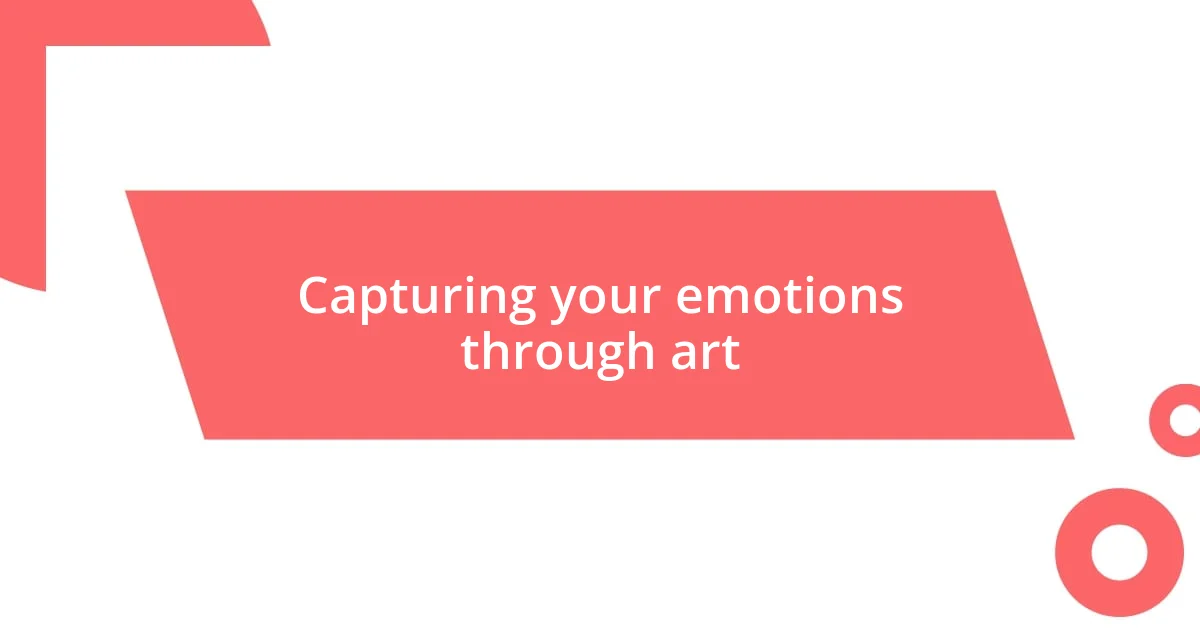Key takeaways:
- Embracing imperfections and individuality in art can enhance one’s unique style and foster deeper connections with viewers.
- Documenting and reflecting on influences, inspirations, and emotional experiences play a crucial role in shaping an artist’s voice and growth.
- Experimenting with different artistic styles and mediums helps uncover hidden preferences and evolves creativity, often leading to personal breakthroughs.

Discovering your creative journey
Discovering your creative journey is often a meandering path filled with self-discovery and unexpected turns. I remember setting aside time each day just to doodle in my sketchbook, and those unplanned moments became a sanctuary where my mind could roam free. Have you ever considered how those seemingly mundane activities can spark deeper insights into your artistic identity?
Revisiting past works can also illuminate your growth. I often look back at some of my earlier pieces and feel a whirlwind of emotions—embarrassment, nostalgia, and pride all swirling together. It really got me thinking: how do our earlier creations shape our current artistic vision? Reflecting on these phases can reveal the threads that connect your past experiences to your present style.
Sometimes, connecting with a community can illuminate your journey in surprising ways. I recall attending a local artist workshop, where sharing my struggles felt like a weight lifting off my shoulders. Engaging with others, I realized that everyone’s journey is unique, yet we all face similar challenges—how might sharing your story change the way you view your own creative path?

Identifying your influences and inspirations
Identifying your influences and inspirations is a vital part of finding your artistic voice. I remember the first time I stumbled upon a particular artist whose style resonated deeply with me. It felt like a light bulb went off—suddenly, I understood how inspiration could unfold from observing others. This experience taught me that acknowledging your influences doesn’t mean copying them; instead, it’s about understanding how they shape your unique perspective.
Often, our influences are not just artists, but also moments and experiences. Once, during a hike, I was mesmerized by the interplay of light and shadow among the trees. That natural beauty sparked an idea for a series of paintings, fueled by the joy of encountering the unexpected. This reinforces how critical it is to remain open to inspiration in every facet of life—often, it lurks in the most mundane experiences.
When I started to consciously document my art inspirations in a journal, I was surprised by the breadth of influences I had accumulated. From music that moved me to the quiet moments of reflection I experienced at sunrise, each entry revealed a rich tapestry of what drives my creativity. By putting pen to paper and reflecting on these influences, I began to recognize patterns that indicated my artistic core. What about you—have you ever considered keeping a record of those moments that inspire you?
| Influence Type | Impact on My Art |
|---|---|
| Visual Artists | Inspired my color choices and composition techniques. |
| Nature | Introduced themes of tranquility and impermanence. |
| Music | Influenced the emotional depth of my pieces. |
| Personal Experiences | Provided a narrative thread evident in my work. |

Experimenting with different styles
Experimenting with different styles can be both exhilarating and daunting. I remember the first time I decided to try my hand at abstract art. It felt liberating to step away from the confines of realism and embrace the chaos of color and form. That experience sparked a deeper understanding of my creative preferences and pushed me to explore further beyond my comfort zone.
- Trying a new style can reveal hidden aspects of your artistic voice.
- Mixing techniques, like collage with painting, can result in unexpected breakthroughs.
- Sometimes, creating art in a completely different medium helps clarify your true passions.
- Documenting each experiment allows you to track your artistic evolution over time.
On another occasion, I took a weekend workshop in figure drawing, which was a significant departure from my usual landscape focus. The experience was initially intimidating, but the thrill of capturing the human form ignited new ideas within me. I felt this rush of creativity flowing as I embraced the vulnerability of drawing subjects in real time, which ultimately led to a fusion of styles in my later work. Each new approach taught me something invaluable about my preferences and artistic instincts.

Embracing your individuality and flaws
Embracing your individuality and flaws is crucial in carving out your artistic voice. I vividly recall a time when I encountered imperfections in my work that I initially wanted to hide. Instead of masking them, I decided to lean into those quirks. They became the signature elements of my style, reminding me that our flaws often reveal our most authentic selves. Have you ever noticed how a simple mistake can lead to a unique discovery in your artwork?
When I drew a series of sketches capturing my own reflection, I was struck by my unconventional features. Instead of shying away, I highlighted them, creating a sense of vulnerability that resonated with viewers. It was a fascinating realization: embracing what makes us different can forge deeper connections with others. How often do we overlook our individuality, thinking it insufficient compared to prevailing standards?
I also remember feeling hesitant about my use of bright, clashing colors. Initially, I thought they were too bold and would distract from my messages. Yet, allowing myself to embrace these choices granted my art a lively energy that drew people in. The experience taught me that what I perceived as flaws could actually amplify my voice—an invaluable lesson for any creative journey.

Capturing your emotions through art
Capturing your emotions through art is a profound journey that connects your inner world with your creative expression. I recall a moment during a rainy afternoon when the melancholic sound of the raindrops inspired me to create a piece that conveyed my feelings of nostalgia. The colors I chose—a blend of deep blues and grays—perfectly mirrored my mood, giving life to emotions I often found difficult to articulate. Have you ever used color to express what words couldn’t?
At one point in my artistic process, I created a series of paintings based on personal memories from my childhood. Each stroke was infused with the warmth of sunshine or the chill of winter, evoking the essence of those moments. The act of painting allowed me to revisit and reflect on my past, turning bittersweet memories into vivid visual experiences. Isn’t it amazing how simply channeling our feelings onto a canvas can transform them into something tangible and relatable?
There’s a unique power in allowing raw emotions to flow through your art. I remember feeling an overwhelming surge of frustration and turning it into an expressive piece filled with erratic lines and bold splashes of color. Instead of hiding my anger, I used it as fuel, and the resulting artwork resonated deeply with others, igniting conversations about shared experiences. In that moment, I discovered that vulnerability can foster connection and understanding—an essential element of creating impactful art.

Reflecting on your artistic growth
Reflecting on my artistic growth has been a journey marked by trial and evolution. I remember an exhibition where my work was displayed alongside that of more established artists. Initially, I felt out of place, doubting whether my perspective had anything meaningful to contribute. Yet, as I engaged with viewers who connected with the rawness of my pieces, I began to realize that my journey, with all its twists and turns, was indeed valid. How often do we doubt our contributions before they even leave our studios?
One moment that stands out was reviewing older pieces and noticing the stark contrast in style and confidence. I was initially shocked by the differences, yet that sparked a profound appreciation for how far I’d come. I learned to embrace the fact that my artistic voice is always a work in progress. It’s fascinating to think about how each phase of my growth adds layers to who I am as an artist. Have you ever felt that your past work feels almost like a different person speaking through you?
As I traversed this path, I discovered that growth isn’t always about perfecting a technique or mastering a medium. Sometimes, it’s about confronting the uncomfortable feelings that arise while creating. I recall finishing a piece that left me emotionally drained yet fulfilled. It taught me that pushing through discomfort often leads to breakthroughs in my artistic voice. Isn’t it remarkable how our most challenging moments can propel us toward what resonates most deeply within us?















